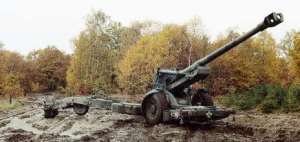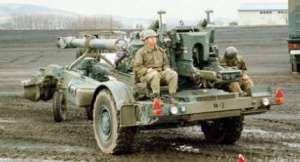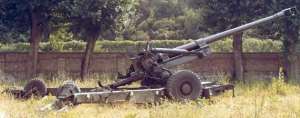| Designation: | FH70 |
 |
|---|---|---|
| Manufacturer: | Marconi Land & Naval Systems Group | |
| Product type: | Weapons & Weapon Systems | |
| Name: | Towed howitzer |
In the early 1960s, Germany, the UK and the US agreed that they had a requirement for a new 155 mm towed field howitzer. Germany and the US wanted to replace their 155 mm M114 howitzers (covered in detail in a separate entry) and the UK wanted to replace its 5.5 in guns. In the end, the US went on to develop the 155 mm M198 which has no APU. Germany and the UK agreed to develop a new weapon, which became known as the FH-70.
The FH-70 MoU was signed in 1968 and the requirement was for a 155 mm howitzer to meet the following military and tactical requirements:
- Continuous high rate of fire with a burst-fire capability
- High mobility with minimum effort for deployment
- Increased range and lethality and a new family of 155 mm separate loading ammunition, for example projectiles and bagged charges
The UK was the project leader for the towed FH-70 and Germany for the self-propelled version called the SP-70, development of which was suspended in 1986.
The first six FH-70 prototypes were completed between 1969-70 and, after accepting the Agreed Operational Characteristics, Italy joined the collaborative project in 1970 as a full partner. The second batch of eight prototypes was completed between 1971 and 1973 and the first international trials battery of six FH-70s was formed in 1975.
A total of 19 prototypes of the FH-70 were completed and after extensive trials the weapon was accepted for service in 1976, with the first production weapons being completed in 1978. Germany ordered 216, Italy 164 and the UK 71 FH-70s.
In May 1982, Saudi Arabia placed an order with International Military Services of the UK for the supply of 72 FH-70 howitzers plus ammunition, muzzle-velocity measuring equipment, fire-control systems and training equipment. By early 1983, the first 18 weapons had been delivered.
The British designation for the FH-70 is the L121 while the Germans call it the FH 155-1. Production for all three countries was completed in 1982. Malaysia took delivery of nine FH-70 systems in 1989 with a further three being delivered in 1993. The FH-70 has also been manufactured under licence in Japan together with its ammunition.
The trilateral responsibilities for production were as follows:
- United Kingdom: carriage, traversing gear, high-explosive projectile (L15) and propelling charge (cartridges numbers 1 and 2)
- Germany: ordnance, loading system, auxiliary propulsion unit, suspension, sighting equipment, smoke and illuminating ammunition and propelling charges (cartridge number 2)
- Italy: cradle, recoil system, sights bracket, elevating gear and arc, high-explosive projectile, smoke and illuminating ammunition and propelling charges (cartridges numbers 2 and 3)
FH-70s have been withdrawn from service by Germany and the UK. The now BAE Systems Land Systems did take a batch of 24 FH-70s for possible export sales, but these have now been scrapped.
According to the United Nations Arms Transfer Lists, the following quantities of 155 mm field howitzer FH-70 weapons were transferred between 1992 and 2006. In each case these were from existing stocks rather than new build weapons.
The elevating mass of the FH-70 comprises the ordnance, cradle with integrated recoil system and the loading mechanism. The ordnance consists of a monobloc barrel fitted with a double-baffle muzzle brake, a breech mechanism incorporating a semi-automatic vertically sliding block and an automatic tube loader with a capacity of nine tubes, spent tube ejection and an emergency firing mechanism.
The cradle, which carries the 155 mm/39 calibre ordnance on slides, includes the recoil system, which consists of a buffer with high-angle cut-off gear and a recuperator. The mechanical main firing system, which is independent of elevation, is carried through one of the cradle trunnions.
The semi-automatic loading system operates at all elevations and traverses and consists of a loading tray, which presents the projectile to the chamber. Together with an automatic tube loader, this system permits a normal rate of fire of 6 rds/min and a burst rate of 3 rounds in 13 seconds.
An automatic loading (flick ramming) system was available as an optional extra and provides a burst fire rate of 3 rounds in 8 seconds.
The carriage is of lightweight construction with saddle, split trails, self-digging spades, main and trail wheels that are operated hydraulically, a soleplate and a detachable APU. When travelling, the barrel is rotated through 180° and clamped between the trails.
The APU is housed in a space frame attached to the forward part of the carriage and consists of a commercial Volkswagen 1,800 cc engine with a gearbox, differential, batteries and a hydraulic pump. In the APU mode the FH-70 can attain speeds up to 16 km/h and is capable of negotiating slopes up to 34 per cent. When being towed, it can ford to a depth of 1.5 m and when using the APU to 0.75 m.
The functions of the APU include driving the main wheels for moving the howitzer, providing hydraulic power for steering and raising and lowering both the main and trail wheels. This facility allows for rapid unhooking, lowering the howitzer onto its soleplate, easy opening and lowering of the trails when going into action, as well as extracting the spades from the ground, lifting the equipment, rapid closing of the trails and limbering up. In an emergency, or when the APU has been removed, power is provided by a hand pump.
The main wheels are hydraulically suspended on swinging arms attached to the carriage body and are cushioned by hydraulic accumulators. Similar suspension elements are used for raising and lowering the trail wheels. Braking of both main wheels is possible from the towing vehicle, or from the APU driver's position on the left side of the carriage.
The trail wheels are attached to the trail end and can be steered, raised and lowered. The hydraulic units providing these functions are controlled from the driver's position and can operate with the trails open or closed. The steering is capable of 60° of movement either side of the centre and for spreading the trails the steering wheels can be turned through 90°.
The sighting system mounted on the left of the saddle consists of a support bracket, a dial sight carrier incorporating a quadrant elevation scale and levelling bubbles, a periscopic dial sight and a direct fire telescope. A direct fire night sight can also be fitted. All scales, graticules and bubbles are self-illuminating. The sight carrier incorporates transducers for azimuth and elevation and in the German and Italian armies these are connected to a Digital Display Unit (DDU) which also receives firing data (azimuth and elevation) from a fire-control computer. The layer lays the gun by nullifying the differences on the DDU and then laying the sight on the gun aiming point. The DDU was not used in UK service.
The FH-70 can be towed on a road at a maximum speed of 100 km/h. Germany used the MAN (6 × 6) 7,000 kg truck to tow the FH-70, Italy uses the FIAT 6605 TM (TM69) and the UK used the Foden (6 × 6) medium-mobility vehicle. The FH-70 is air-portable in a Lockheed Martin C-130 aircraft or underslung under the Boeing CH-47D Chinook helicopter.
A family of 155 mm ammunition was developed for the FH-70 which gives the weapon a significant increase in range and lethality for both direct and indirect firing against armoured targets. The FH-70 can also fire NATO standard ammunition including the US Copperhead Cannon Launched Guided Projectile. The range of ammunition consists of the following projectiles:
- HE projectile (L15A1) which weighs 43.5 kg and is thin walled, with high fragmentation effect and HE capacity of 11.3 kg
- Base Ejection Smoke projectile (DM105), where four smoke canisters fall to the ground giving a dense cloud of smoke in 30 seconds
- Illuminating (DM106) which provides illumination of 2.1 million candelas for 60 seconds
The ERP (Extended Range Projectile) which will increase the range of the FH-70 to over 30,000 m is US M549A1 rocket-assisted projectile and RO30 base bleed (BB).
The eight-zone charge system uses triple-based propellant and is divided into three separate cartridges, containing zones 1 and 2, 3 to 7 and 8 respectively. The charge system is ballistically balanced, has a clean combustion and is initiated by a percussion inner tube (DM 191A1). Muzzle velocity ranges from 213 to 827 m/s. Using the now BAE Systems Land Systems BIS 14 propelling charge the FH-70 can fire an ERFB BB projectile to a range of 31,000 m.
Using the APU, the FH-70 can be unhooked, manoeuvred into position and put into action in less than two minutes and taken out of action in a similar period. If a target moves outside the traverse limits the trails can be raised hydraulically, thereby pulling the spades from the ground. The gun can then be wheeled about its soleplate to a new target. With the trails lowered the first shot will embed the spades.
Apart from the usual preliminary checking of the equipment, the gun detachment has only to open the breech by hand, load the first projctile and propelling charge and place the second projectile on the loading tray. The breech is closed and an ignition tube is automatically loaded from the nine-tube magazine. After this sequence, which takes less than 5 seconds, the FH-70 is ready for action. When the FH-70 is ready and laid correctly, all that is required for firing is for the layer to pull the firing handle. Thereafter, the sequence of operation becomes semi-automatic. The recoil system and muzzle brake jointly absorb the recoil forces as the gun recoils on the cradle slides to a maximum of 1.4 m. On running out to the firing position, the following operations take place simultaneously: The breech is opened automatically by a cam, the spent tube is ejected and the next 155 mm projectile is lifted to the breech and aligned in the chamber before final hand ramming. The detachment then rams the projectile and loads the propelling charge, places the next projectile in the loading tray, closes the breech, if necessary relays the gun and fires again. A flick ramming device is available as an optional extra giving a burst rate of 3 rounds in 8 seconds and reducing crew fatigue.
Other options included a direct fire image intensification night sight, deflector boxes and mainwheel mudguards.
The Japanese Ground Self-Defence Force selected the FH-70 to replace its 155 mm M114 towed howitzers and production was undertaken under licence in Japan. Prime contractor in Japan was the Japan Steel Works. Rheinmetall was responsible for the Japanese contract.
For the world market a simplified sighting system was available, which utilised the now BAE Systems Land Systems 105 mm Light Gun sighting system with a modified graticule in the direct fire telescope. It can be fitted to the standard gun via an adaptor on the left-hand trunnion.
For trials purposes Rheinmetall has fitted an FH-70 with a 52 calibre ordnance that conforms with the new quadrilateral ballistic agreement. This enables a range of 30,000 m to be achieved with the L15A1 projectile, or 40,000 m with BB projectiles. This is no longer marketed.
The Italian company Applicazioni Rielaborazioni Impianti Speciali (ARIS) have completed development of a new diesel Auxiliary Power Unit (APU) for installation on the 155 mm FH-70 towed artillery system.
The original production FH-70 has the APU installed on the front of the carriage. This consists of a Volkswagen 1,800 cc engine with a gearbox, differential, batteries and hydraulic pump.
The installation of the APU allows the FH-70 to attain a maximum road speed of 16 km/h as well as climbing slopes of up to 34 per cent.
In addition to providing the power to move the FH-70 system over short distances, especially over terrain that cannot be reached by the 6 × 6 prime mover, the APU also provides hydraulic power for steering and raising and lowering the main and trail wheels. The installation of the APU reduces crew fatigue as well as speeding into and out of action times.
The new ARIS diesel powered APU can be installed on the 155 mm FH-70 in only 2 hours and uses standard proven Commercial-Off-The-Shelf (COTS) components to reduce overall life cycle costs.
The system has been evaluated by the Italian Army and is almost a direct replacement for the current APU and takes less than 2 hours to install. It gives the FH-70 a maximum road speed of 15 km/h and it can climb gradients of 40 per cent.
|
||||||||||||||||||||||||||||||||||||
|
|||||||||
|
||||||||||||||||||||||||||||||||||||||||||
 |
 |
 |
 |
 |
 |











